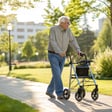Gardening brings joy to many seniors, but it can also strain joints and challenge balance. Finding ways to nurture plants without nurturing pain is essential.
Understanding Joint Protection While Gardening
Gardening involves repetitive movements that can stress joints, particularly for those with existing conditions like arthritis. According to Versus Arthritis, while gardening offers tremendous physical and mental health benefits, certain repetitive tasks can aggravate joint pain if proper precautions aren't taken.
When digging, weeding, or pruning, our knees, wrists, and back often bear the brunt of the strain. Dr. James Miller, an orthopedic specialist at Southern Pain Clinic, notes that "many gardening injuries occur because people ignore early warning signs of discomfort and push through pain."
The key is adapting your approach rather than abandoning your garden altogether. Practice Plus Group recommends several techniques for joint protection:
- Use ergonomic tools with padded grips
- Take frequent breaks (every 20-30 minutes)
- Alternate between different gardening tasks
- Apply heat before gardening to loosen joints
- Use ice afterward if inflammation occurs
These simple adjustments can make a significant difference in how your body responds to gardening activities.
Gardening Safety for Seniors
Safety becomes increasingly important as we age. Falls represent one of the biggest risks for senior gardeners, with potentially serious consequences.
"Many seniors underestimate how physically demanding gardening can be," says Emma Thompson, occupational therapist and garden safety consultant. "Creating a safer gardening environment should be your first priority."
Consider these essential safety measures:
- Install handrails along garden paths
- Use raised beds to minimize bending
- Garden during cooler morning hours to prevent heat exhaustion
- Keep a cell phone nearby in case of emergency
- Wear non-slip footwear with good traction
The NHS emphasizes that maintaining bone health is crucial for preventing fractures. Their guidance suggests weight-bearing activities like walking between gardening tasks can actually strengthen bones while giving joints a break from repetitive movements.

Protecting Balance While Tending Plants
Balance challenges shouldn't keep you from enjoying your garden. In fact, gardening can actually improve balance when approached thoughtfully.
"Gardening involves weight shifting, reaching, and other movements that can enhance proprioception—your body's awareness of its position in space," explains physical therapist Robert Johnson. "But you need to create an environment that supports these movements safely."
Some practical strategies include:
- Sit rather than kneel when possible
- Use a garden stool that can be easily moved
- Install vertical gardens to reduce bending
- Create wider, stable paths between garden beds
- Consider container gardening on tables or raised surfaces
The Arthritis Foundation points out that balance exercises can complement your gardening routine. Their recommendation is to practice simple balance activities, like standing on one foot while holding onto a sturdy surface, before heading out to the garden.
How Can I Garden Without Hurting My Knees?
This is perhaps the most common question among senior gardeners. Knee pain can quickly turn a pleasant hobby into an uncomfortable chore.
Long-handled tools are your first line of defense, allowing you to work while standing rather than kneeling. When kneeling is necessary, a thick foam kneeling pad or gardening bench with handles provides crucial support.
Southern Pain Clinic suggests wearing knee braces during gardening sessions if you have existing knee issues. They also recommend gentle knee-strengthening exercises during the off-season to better prepare your joints for spring and summer gardening.
"What many don't realize is that proper nutrition also plays a role in knee health," notes nutritionist Claire Williams. "Anti-inflammatory foods like fatty fish, berries, and olive oil can help manage pain when incorporated into your regular diet."
Adaptive Tools and Techniques
The right tools can transform your gardening experience. Look for:
- Long-handled tools with ergonomic grips
- Lightweight watering cans and hoses
- Garden carts rather than heavy wheelbarrows
- Ratchet pruners that multiply your hand strength
- Vertical trellises to bring plants to you
Practice Plus Group recommends trying tools before purchasing when possible, as hand size and grip strength vary significantly between individuals.
Disclaimer
This information is provided for educational purposes only and is not a substitute for professional medical advice. Always consult with your healthcare provider before beginning or modifying any gardening routine, especially if you have existing joint problems, balance issues, or other health concerns.
Remember: The joy of gardening shouldn't come with the price of pain. With thoughtful adaptations, you can continue nurturing your garden while protecting your body.
Tags

About Evelyn Grant the Author
Evelyn Grant is a trailblazer in the world of cycling fashion, known for combining functionality with style. With over a decade of experience, she designs apparel that meets the demands of avid cyclists while making a bold fashion statement.
Recommended Articles
4 Everyday Drinks Being Studied for Circulation Support
Explore 4 everyday drinks that may enhance circulation, including herbal teas, coffee, red wine, and beetroot juice. Discover their health benefits.
Why More Seniors Are Considering Compact Mobility Tech
Explore how compact mobility tech enhances independence and quality of life for seniors, making daily activities more accessible and enjoyable.
Why More Seniors Are Replacing Walkers With This Sleek Device
Discover why seniors are opting for sleek mobility devices over traditional walkers, enhancing their independence with style and functionality.
2025 Cadillac CT4 Combines Performance With Refined Luxury
Discover the 2025 Cadillac CT4, where thrilling performance meets luxury, featuring advanced safety, elegant interiors and powerful engine options.
2025 Lexus RX Keeps the Luxury SUV Crown With Smarter Features
The 2025 Lexus RX redefines luxury SUVs with advanced tech, safety features, and a focus on comfort for an unparalleled driving experience.




